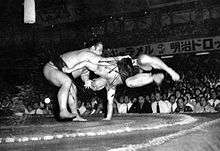Azumafuji Kin'ichi
Azumafuji Kin'ichi (Japanese: 東富士 欽壹, October 28, 1921 – July 31, 1973) was a Japanese professional sumo wrestler from Taitō, Tokyo. He was the sport's 40th yokozuna, and later a professional wrestler.
| 東富士 欽壹 Azumafuji Kin'ichi | |
|---|---|
Azumafuji holding the Emperor's Cup after winning the 1950 summer tournament | |
| Personal information | |
| Born | Inoue Kin'ichi October 28, 1921 Tokyo, Japan |
| Died | July 31, 1973 (aged 51) |
| Height | 1.79 m (5 ft 10 1⁄2 in) |
| Weight | 178 kg (392 lb; 28.0 st) |
| Career | |
| Stable | Takasago |
| Record | 335-137-54-1draws-1hold |
| Debut | January 1936 |
| Highest rank | Yokozuna (October 1948) |
| Retired | September, 1954 |
| Elder name | Nishikido |
| Championships | 6 (Makuuchi) 1 (Jūryō) 1 (Makushita) |
| * Up to date as of June 2020. | |
Sumo career

His real name was Inoue Kin'ichi (井上 謹一). He made professional debut in January 1936, joining Takasago stable. He was promoted to the top makuuchi division in May 1943. On the sixth day of the November 1944 tournament, he defeated yokozuna Futabayama, the last wrestler ever to do so as Futabayama pulled out of the tournament the next day and only fought one more bout before his retirement. Azumafuji was promoted to ōzeki in June 1945 on the strength of two runner-up performances. He won his first top division championship in May 1948, and was promoted to the top yokozuna rank in October of that year after finishing as runner-up. Going against historical trends, he managed to win his debut yokozuna tournament, in January 1949.
On the 12th day of the September 1951 tournament, Azumafuji recorded an azukari, or hold, a rare result. On that day, he had come down with acute pneumonia but he forced himself to continue in the tournament as he had only one loss. Azumafuji fought with then ōzeki Yoshibayama twice, but the outcome still could not be determined. After the second bout, Azumafuji could not stand up any more and conceded defeat, but the gentlemanly Yoshibayama insisted that the fairest result was to declare a hold, which was confirmed by the officials. Azumafuji went on to win the tournament, his fourth championship.
Azumafuji won his sixth and final championship in September 1953, and struggled with injuries after that. In September 1954, ōzeki Tochinishiki seemed certain to win his second consecutive championship. Azumafuji suddenly announced his retirement at that tournament, not wishing to hinder Tochinshiki's promotion to yokozuna.[1] Had he remained, Tochinishiki would have become the fifth active yokozuna, an unprecedented situation. Tochinishiki reportedly asked Azumafuji to reconsider his decision, but to no avail.[1]
Professional wrestling career
Azumafuji was the first yokozuna to turn to Western-style professional wrestling, in 1955. This occurred after a dispute in the Japan Sumo Association between two other elders, Takasago and Tatsunami, which he wished to escape.[1] In April 1955 he won the Hawaiian Tag Team title in Honolulu alongside another former sumo wrestler turned professional wrestler, Rikidōzan. In 1956 he defeated former judoka Toshio Yamaguchi to win the Japanese Heavyweight tournament.[2] This tournament was supposed to give him a shot at Rikidozan, at the time the Japanese Heavyweight Champion, but the match never took place.
Sumo top division record
- From 1953 a New Year tournament was added and the Spring tournament began to be held in Osaka.
| - | Spring Haru basho, Tokyo |
Summer Natsu basho, Tokyo |
Autumn Aki basho, Tokyo |
|||
|---|---|---|---|---|---|---|
| 1943 | x | East Maegashira #8 10–5 |
Not held | |||
| 1944 | West Maegashira #1 7–4–4 |
East Maegashira #2 6–4 |
West Sekiwake 9–1 |
|||
| 1945 | Not held | East Sekiwake #1 6–1 |
East Ōzeki #1 9–1 |
|||
| 1946 | Not held | Not held | East Ōzeki #1 7–6 |
|||
| 1947 | Not held | West Ōzeki #2 9–1–P |
West Ōzeki #1 6–5 |
|||
| 1948 | Not held | West Ōzeki #2 10–1 |
West Ōzeki #1 10–1–P |
|||
| 1949 | West Yokozuna #2 10–2 1d |
East Yokozuna #1 8–7 |
West Yokozuna #2 10–5 |
|||
| 1950 | West Yokozuna #1 6–6–3 |
West Yokozuna #1 14–1 |
East Yokozuna #1 11–4 |
|||
| 1951 | West Yokozuna #1 10–5 |
East Yokozuna #2 12–3 |
East Yokozuna #1 13–1 1h |
|||
| 1952 | East Yokozuna #1 7–4–4 |
West Yokozuna #2 13–2 |
East Yokozuna #1 7–7–1 |
|||
| Record given as win-loss-absent Top Division Champion Top Division Runner-up Retired Lower Divisions Sanshō key: F=Fighting spirit; O=Outstanding performance; T=Technique Also shown: ★=Kinboshi(s); P=Playoff(s) | ||||||
| - | New Year Hatsu basho, Tokyo |
Spring Haru basho, Osaka |
Summer Natsu basho, Tokyo |
Autumn Aki basho, Tokyo | ||
|---|---|---|---|---|---|---|
| 1953 | West Yokozuna #1 2–5–8 |
West Yokozuna #2 12–3 |
East Yokozuna #1 11–4 |
West Yokozuna #1 14–1 |
||
| 1954 | East Yokozuna #1 3–7–5 |
West Yokozuna #2 5–3–7 |
East Yokozuna #2 Sat out due to injury 0–0–15 |
East Yokozuna #2 Retired 4–4–7 |
||
| Record given as win-loss-absent Top Division Champion Top Division Runner-up Retired Lower Divisions Sanshō key: F=Fighting spirit; O=Outstanding performance; T=Technique Also shown: ★=Kinboshi(s); P=Playoff(s) | ||||||
*d = draw (引分) / h = hold (預り)
See also
References
- Kuroda, Joe (October 2007). "Tochinishiki Kiyotaka (1925–1990) the 44th Yokozuna Part 2". Sumo Fan Magazine. Retrieved 2008-05-01.
- History of Puroresu : The Rikidozan Era
- "Azumafuji Kinichi Rikishi Information". Sumo Reference. Retrieved 2007-10-15.
External links
| Preceded by Maedayama Eigorō |
40th Yokozuna 1948–1954 |
Succeeded by Chiyonoyama Masanobu | ||
| Yokozuna is not a successive rank, and more than one wrestler can hold the title at once | ||||